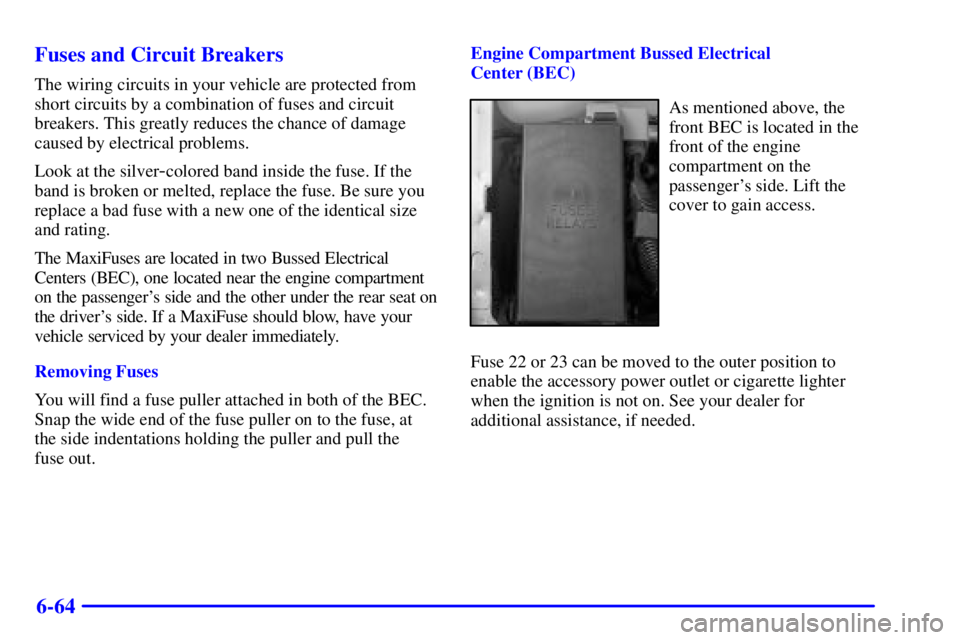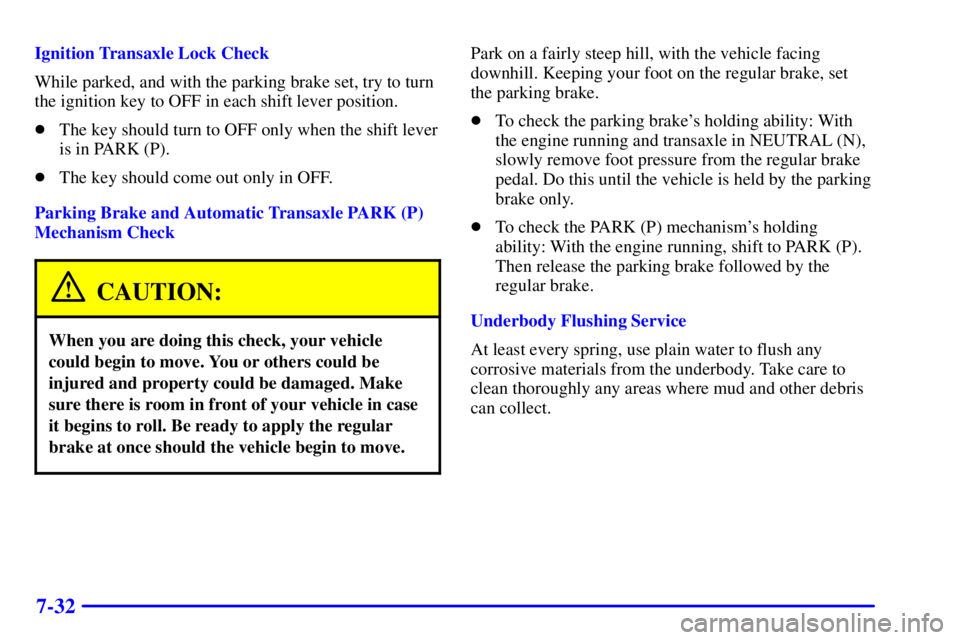Page 332 of 413

6-47
When the CHECK TIRE PRESSURE message appears
on the Driver Information Center or the systems monitor
TIRE PRESS light comes on, you should stop as soon as
you can and check all your tires for damage. If a tire is
flat, see ªIf a Tire Goes Flatº in the Index. Also check
the tire pressure in all four tires as soon as you can.
See ªInflation
-Tire Pressureº in the Index.
Any time you adjust a tire's pressure or have one or
more tires repaired or replaced, you'll need to reset
(calibrate) the check tire pressure system. You'll also
need to reset the system whenever you rotate the tires,
buy new tires, install or remove the compact spare, and
whenever the vehicle's battery has been disconnected.
Don't reset the check tire pressure system without first
correcting the cause of the problem and checking and
adjusting the pressure in all four tires. If you reset the
system when the tire pressures are incorrect, the check
tire pressure system will not work properly and may not
alert you when a tire is low or high.
To reset (calibrate) the system with a Driver Information
Center (DIC):
1. Turn the ignition switch to ON.
2. Using the MODE and SELECT buttons, change the
DIC to display TIRE PRESSURE.
3. Press and hold the RESET button for about
five seconds.4. The display should change to read TIRE PRESSURE
RESET. If TIRE PRESSURE RESET does not
appear on the display after about five seconds, see
your dealer for service.
5. When you release the button after seeing the TIRE
PRESSURE RESET message, the display will
change to read TIRE PRESSURE NORMAL.
To reset (calibrate) the system with a systems monitor:
1. Turn the ignition switch to ON.
2. Press and hold the TIRE PRESS RESET button for
about five seconds.
3. The TIRE PRESS light on the systems monitor
should begin to flash. If the TIRE PRESS light does
not begin to flash after about five seconds, see your
dealer for service.
4. Release the TIRE PRESS RESET button and the
system should reset The TIRE PRESS light will
go out.
The system completes the calibration process during
driving. Calibration time can take 45 to 90 minutes,
depending on your driving habits. After the system has
been calibrated, the system will alert the driver that a tire
is low, up to a maximum speed of 65 mph (105 km/h).
Page 349 of 413

6-64 Fuses and Circuit Breakers
The wiring circuits in your vehicle are protected from
short circuits by a combination of fuses and circuit
breakers. This greatly reduces the chance of damage
caused by electrical problems.
Look at the silver
-colored band inside the fuse. If the
band is broken or melted, replace the fuse. Be sure you
replace a bad fuse with a new one of the identical size
and rating.
The MaxiFuses are located in two Bussed Electrical
Centers (BEC), one located near the engine compartment
on the passenger's side and the other under the rear seat on
the driver's side. If a MaxiFuse should blow, have your
vehicle serviced by your dealer immediately.
Removing Fuses
You will find a fuse puller attached in both of the BEC.
Snap the wide end of the fuse puller on to the fuse, at
the side indentations holding the puller and pull the
fuse out.Engine Compartment Bussed Electrical
Center (BEC)
As mentioned above, the
front BEC is located in the
front of the engine
compartment on the
passenger's side. Lift the
cover to gain access.
Fuse 22 or 23 can be moved to the outer position to
enable the accessory power outlet or cigarette lighter
when the ignition is not on. See your dealer for
additional assistance, if needed.
Page 350 of 413
6-65
Minifuse Usage
1 Not Used
2 Accessory
3 Windshield Wipers
4 Not Used
5 Headlamp Low Beam Left
6 Headlamp Low Beam Right
7 Spare
8 Powertrain Control
Module BatteryMinifuse Usage
9 Headlamp High Beam Right
10 Headlamp High Beam Left
11 Ignition 1
12 Not Used
13 Transaxle
14 Cruise Control
15 Direct Ignition System
16 Injector Bank #2
17 Not Used
18 Not Used
19 Powertrain Control
Module Ignition
20 Oxygen Sensor
21 Injector Bank #1
22 Auxiliary Power
23 Cigar Lighter
24 Fog Lamps/Daytime
Running Lamps
25 Horn
26 Air Conditioning Clutch
Page 351 of 413
6-66
Mirco Relay Usage
27 Headlamp High Beam
28 Headlamp Low Beam
29 Fog Lamps
30 Daytime Running Lamps
31 Horn
32 Air Conditioning Clutch
33 HVAC Solenoid
Mini Relay Usage
34 Accessory
35 Air Pump
36 Starter 1
37 Cooling Fan Secondary
38 Ignition 1
39 Cooling Fan Series/Parallel
40 Cooling Fan PrimaryMaxibreaker Usage
41 Starter
Maxifuse Usage
42 A.I.R.
43 Antilock Brake System
44 Not Used
45 Not Used
46 Cooling Fan Secondary
47 Cooling Fan Primary
48 Spare
49 Spare
50 Spare
51 Spare
52 Spare
53 Fuse Puller
Page 355 of 413
6-70
Minifuse Usage
9 Not Used
10 Lamps Park Right
11 Ventilation Solenoid
12 Ignition 1
13 Lamps Park Left
14 Interior Lamp Dimmer Module
15 Not Used
16 Heated Seat Left Front
17 Not Used
18 Rear Door Modules
19 Stoplamps
20 PARK (P) / REVERSE (R)
21 Audio
22 Retained Accessory Power
23 Not Used
24 Not Used
25 Passenger Door Module
26 Body
27 Interior Lamps
28 Not Used
29 Ignition SwitchMinifuse Usage
30 Instrument Panel
31 Heated Seat Right Front
32 Not Used
33 Heating, Ventilation,
Air Conditioning
34 Ignition 3 Rear
35 Antilock Brake System
36 Turn Signal/Hazard
37 HVAC Battery
38 Dash Integration Module
Micro Relay Usage
39 Fuel Pump
40 Parking Lamps
41 Ignition 1
42 Not Used
43 Not Used
44 Park Brake
45 Reverse Lamps
46 Retained Accessory Power
Page 356 of 413
6-71
Micro Relay Usage
47 Fuel Tank Door Lock
48 Not Used
49 Ignition 3
50 Fuel Tank Door Release
51 Interior Lamps
52 Trunk Release
53 Front Courtesy Lamps
54 Not Used
55 Electronic Level
Control Compressor
Circuit Breaker Usage
56 Power Seats
57 Power Windows
Mini Relay Usage
58 Cigarette Lighter
59 Rear DefogMaxifuse Usage
60 Not Used
61 Rear Defog
62 Not Used
63 Audio Amplifier
64 Electronic Level Control
Compressor/Exhaust
65 Cigarette Lighter
66 Not Used
67 Spare
68 Spare
69 Spare
70 Spare
71 Spare
72 Spare
73 Spare
74 Spare
75 Fuse Puller
Page 390 of 413

7-32
Ignition Transaxle Lock Check
While parked, and with the parking brake set, try to turn
the ignition key to OFF in each shift lever position.
�The key should turn to OFF only when the shift lever
is in PARK (P).
�The key should come out only in OFF.
Parking Brake and Automatic Transaxle PARK (P)
Mechanism Check
CAUTION:
When you are doing this check, your vehicle
could begin to move. You or others could be
injured and property could be damaged. Make
sure there is room in front of your vehicle in case
it begins to roll. Be ready to apply the regular
brake at once should the vehicle begin to move.
Park on a fairly steep hill, with the vehicle facing
downhill. Keeping your foot on the regular brake, set
the parking brake.
�To check the parking brake's holding ability: With
the engine running and transaxle in NEUTRAL (N),
slowly remove foot pressure from the regular brake
pedal. Do this until the vehicle is held by the parking
brake only.
�To check the PARK (P) mechanism's holding
ability: With the engine running, shift to PARK (P).
Then release the parking brake followed by the
regular brake.
Underbody Flushing Service
At least every spring, use plain water to flush any
corrosive materials from the underbody. Take care to
clean thoroughly any areas where mud and other debris
can collect.